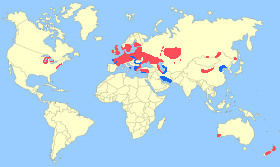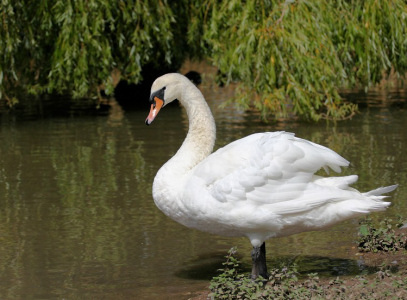Appearance: - The Mute Swan is one of the largest and heaviest flying birds. They are all white with a slight yellow-orange tinge on top of the head, orange-red beak which has a black tip, the legs and feet are black, and they have a distinctive black knob above the beak which is much larger on the male (Cob) than the slightly smaller female (Pen). The cygnets are grey-brown with grey legs and beak.
Size: - Typical Adult is 125-170cm (49-67in).
Food: - Aquatic plants, sedges, pond-weed which they can reach with their long necks, and they will also graze on grass when out of water. They will also eat more animal matter than any other swan such as insect larvae, tadpoles, small fish, small frogs, and molluscs.
Habitat/Range: - Lakes, rivers, canals, parks, ponds in temperate zone in the UK, Europe, and Asia. Most populations winter in their breeding grounds and others migrate further south. The Mute Swan has also been introduced to North America, and Australasia.

 Breeding Habitat/Resident,
Breeding Habitat/Resident,  Migration or Winter Area.
Migration or Winter Area.Breeding Season: - Late April to early May.
Eggs: - 4 to 7 (greyish-white colour).
Notes: - The Mute Swan is the largest species of Swan and also the least vocal which is how it came by its name. However, you can hear a distinctive throbbing sound from its powerful wings during flight which is unique to its species and can be heard from up to a mile away.
Conservation status (IUCN 3.1):
Least Concern.
Classification: - Family: Anatidae,
Subfamily: Anserinae, Genus: Cygnus.








































































